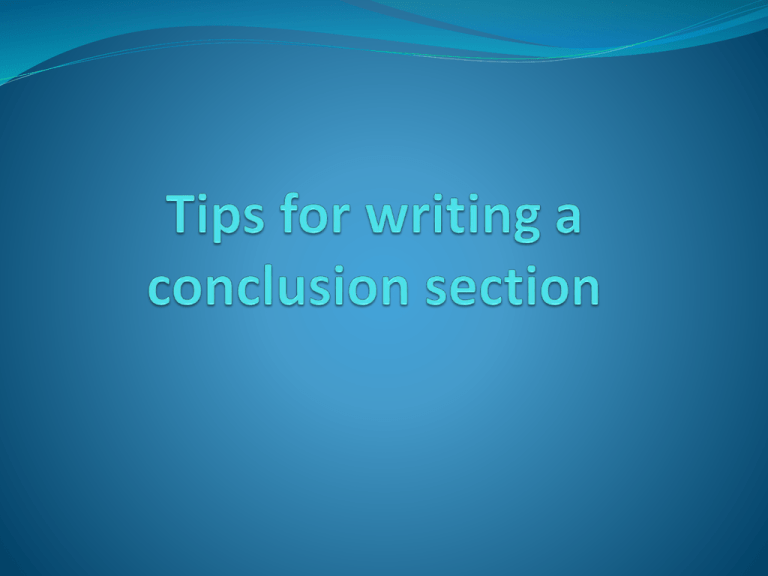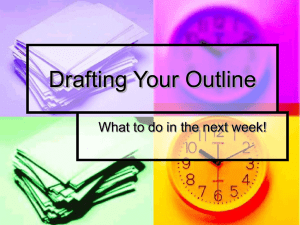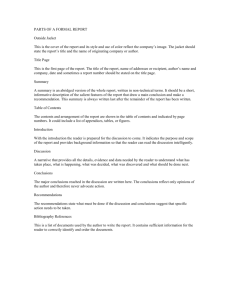Writing a conclusion section
advertisement

References The Writing Center: − http://writingcenter.unc.edu/handouts/conclusions/ Strategies for Writing a Conclusion. Literacy Education Online, St. Cloud State University. 18 May 2005 − http://leo.stcloudstate.edu/acadwrite/conclude.html How to write a research journal article in engineering and science. Scott A. Socolofsky, Texas A&M Univ. What can conclusion section do for your paper? Interprets the numbers in “Results” section. Tell the audience why your findings are important to them, how they can use them. Help readers come to a new or broader understanding of the topic. Give the paper a sense of completeness. Leave a final impression on the reader about you as a researcher. The conclusion section brings the paper “full circle” Introduction: General specific “Anthropomorphic measures can be used to identify obesity and underlying chronic diseases. But cut-off points used in Indonesia have poor sensitivity characteristics.” Conclusion: Specific back to general “The new cut-off points we propose will more accurately identify obesity cases and those at risk to chronic diseases.” Why is this section so difficult? You are tired, mentally exhausted − Do I have anything left to say? It requires a deeper level of thought and analysis − What do the findings mean? − What do I expect the audience to do with the information? Here is where it is most challenging, but most critical, to maintain your research objectivity. Take a break. Contemplate. Then BERSEMANGAT dan TAHAN! 6 organizing options 1. Answer the “So what” question. “Jamkesmas enrollees have inpatient utilization rates 3 times higher than any other group.” – This is important because ____? 2. Return to the theme in the introduction. “ART currently available in the international market is not affordable for most Indonesians. This study showed we can achieve similar results with more affordable technology.” 6 organizing options 3. Include a provocative insight. “Current donor policies are oversupplying the market with subsidized contraceptives, squeezing out the private sector, and reducing long-run product availability.” 4. Propose a course of action, a solution, or questions for further study. “The Government should end universal subsidies and implement policies better targeted to poor and vulnerable populations.” 6 organizing options 5. Give your reader a way to connect your findings to their world. “Understanding urban, agricultural and fishing community somatotype profile differences will help planners better target child growth programs and reduce disparities.” 6. Point to broader implications. “The finding that HIV infection rates are rising fast among key bridge populations suggests broad prevention strategy changes are needed to reduce risks for a generalized epidemic.” Before you write, know your journal What is your journals focus? − Policy? Implementation? Clinical? Who reads this journal? − That is your audience Read the conclusion section of several articles from your selected journal. − Are they short? Long? − Is there a common focus? − Which of the 6 organizing options is most common? Writing: create a “logical flow” 1. Reconnect with the main research question. “We conducted this study to answer the question about how method and provider choice changed when IUD subsidies were withdrawn from private providers.” 2. Provide the answer to the research question. “There were major shifts from IUDs to injectables and from private midwives to public clinics.” 3. Tell the reader why the answer is important. “An important business income base has been lost by private midwives… The public sector will need more resources to meet increased demand at public clinics.” Give your reader closure at the end Major unanswered questions. Topics needing further research. Limitations to generalizability or how the findings can be used. Some things to avoid Don’t repeat; interpret “30,7% of patients did not return to refill their TB treatment prescription.” vs. “The high proportion of treatment noncompliance observed risks treatment failure and development of more difficult and more costly to treat MDR TB.” … more things to avoid Don’t introduce a new idea or hypothesis that was not in the introduction. Don’t repeat or restate numbers from the results section. − Interpret what the numbers mean. Don’t make dramatic, sentimental, emotional statements. − Be clear about research/science vs. advocacy. “The tireless dedication of brave health providers who toil under harsh conditions should be recognized as a great sacrifice.” Don’t add new evidence that is not in the results section. “Rural-urban differences are greater than any other difference.” References The Writing Center: − http://writingcenter.unc.edu/handouts/conclusions/ Strategies for Writing a Conclusion. Literacy Education Online, St. Cloud State University. 18 May 2005 − http://leo.stcloudstate.edu/acadwrite/conclude.html How to write a research journal article in engineering and science. Scott A. Socolofsky, Texas A&M Univ.





